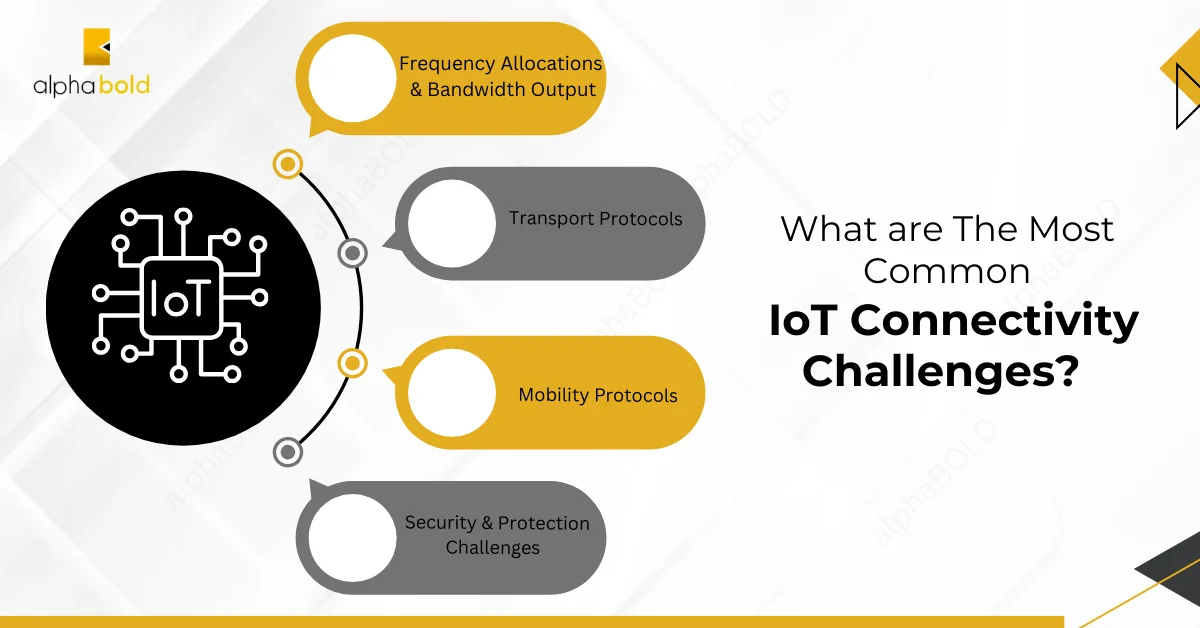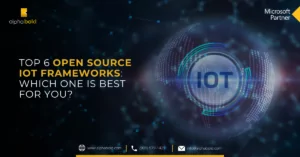Introduction
In this blog, we’ll discuss the most common IoT connectivity challenges and strategies your business can use to overcome these challenges.
The Internet was created and improved over time for traditional devices like computers. However, the Internet of Things (IoT) has brought about new problems that need to be solved in order to use and deploy IoT services successfully. Low-cost IoT devices have restrictions on battery life, processing power, memory, and storage. IoT devices occasionally do not adhere to the TCP/IP stack. This is due to the market saturation of IoT suppliers and limited certification options. These features of IoT devices become the reason for closed, vendor-specific, vertical IoT deployments.
Because IoT is so widespread, problems with connection, interoperability, administration, and security standards are unavoidable. These problems are exacerbated when you include power-constrained devices with a long battery life and send data frequently across unreliable networks. We need effective solutions to address these unanticipated challenges that have evolved since the widespread adoption of the Internet protocol.
What are The Most Common IoT Connectivity Challenges?
Connectivity has two very important aspects: data transfer from sensors and instructions to actuators. This makes connectivity a vital component of IoT devices and services. When it comes to IoT, there are several layers at which a connection can be assessed, beginning with frequency bands at the physical layer and moving on to link layer MAC protocols, network layer mobility, and transport layer protocols.
Let’s discuss the most common IoT connectivity challenges devices and services associated with this technology can face.

1. Frequency Allocations and Bandwidth Output:
2. Transport Protocols:
The Internet’s transport layer controls traffic and makes sure that bits of information are delivered reliably and in the correct order. Transmission Control Protocol (TCP) uses this transport layer very efficiently. But, because IoT devices have a mixed traffic pattern due to their restrictions, TCP isn’t a good fit for IoT applications.
- First, it’s difficult to keep the communication and acknowledgment channels open when IoT devices often enter sleep mode after sending or receiving a data packet because of energy conservation considerations.
- Second, TCP handshakes generate too much cost for IoT devices, which transmit and receive very little data.
- Thirdly, there is a significant time difference between TCP and the low latency needs of IoT applications regarding connection setup.
- Lastly, as IoT applications function in the lossy domain, communication would be blocked until all packets in the preceding order had been properly delivered.
3. Mobility Protocols:
The mobility of IoT devices is key to multiple IoT solutions, including logistics, asset management, person tracking, vehicle monitoring, and patient tracking. Because of memory and CPU limitations and battery life problems, existing mobile IP protocols are inadequate for IoT use cases.
For IoT, we consider two mobility protocols: one that relies on hosts and another that uses networks. When transferring to a different network, a Mobile Node (MN) or IoT device must inform the Home Agent (HA) of its Care-off Address (CoA) and have an IP address that can be reached globally for host-based mobility to operate. This kind of mobility is expensive and uses much power since it relies on intermediary mesh nodes to transmit mobility control signals instead of the MN.
In network-based mobility, an agent processes mobility messages on the MN’s behalf. When a new MN is detected, the Mobility Access Gateway (MAG) immediately sets up connections with the Local Mobility Anchor (LMA) using signaling.
Bonus reading: 4 Sectors That Benefit from IoT Development in 2025.
4. Security and Protection Challenges:
Security must always be a priority when evaluating an IoT application, which is especially important in an industrial context. If you want the highest level of security for your IoT connectivity solutions, ensure they’re tested, validated, and regularly updated and patched. Businesses should first ask their providers about these few things:
- Their security disclosure procedure
- How they handle zero-day vulnerabilities
- What fixes are available
- How often do they maintain and update the software
Due to Microsoft’s recent strictness on remote procedure calls (RPC), businesses need to take care when introducing changes to their operational environment. If they don’t, they risk losing connectivity and experiencing painful downtime. When it comes to manufacturing, businesses face the challenge of maintaining software and firmware without sacrificing productivity due to IoT connections.
Although there’s a strong need to guarantee compliance and security, updates are often not applied to operating technology and devices. And since visibility into the equipment is lacking, the software development cycle is unreadable, or fixes are simply not possible.
Is your IoT Network in Need of Professional Guidance?
The IoT specialists at AlphaBOLD can help you with any task, from managing complicated transport protocols to guaranteeing the safe transfer of data. Schedule a consultation and we can work together to resolve your connectivity problems.
Request a Consultation5 Useful Tips to Solve IoT Connectivity Challenges
Tip 1: Diversify Your Connectivity Methods
The ability of the network to quickly transmit signals and data inside an IoT system is known as bandwidth, which is vital for an IoT connection. The best solution for you is to diversify your IoT service’s or device’s connectivity methods. Multiple connection technologies can help you with the diversifying strategy, including Wi-Fi, 5G, and Low Power Wide Area Networks (LPWAN).
Consider this an example: A telecom analysis found that data transmission rates could improve by more than 100% when 5G is included. Moreover, Ericsson’s projections say that 1.5 billion people have signed up for the modern 5G mobile broadband services, and by 2024, 40% of the world’s population will be covered by 5G networks.
Learn about our manufacturing IoT solutions: BOLDConnect.
Tip 2: Perform Routine Network Health Checks
Tip 3: Choose Cloud Infrastructure that Supports Scalability and Growth
Many companies face IoT connectivity challenges in terms of scalability as their IoT networks expand, which impacts connection and performance. Ericsson predicts that the interconnected devices will reach 24 billion by 2050. Let’s put that in perspective. This means that everything around us might be a part of an IoT network.
IoT operations can be more adaptable if you choose scalable cloud solutions. If you want to maintain uninterrupted connectivity for your customers or business teams, choose cloud systems that allow for the distribution of resources on demand. These cloud systems can adjust to the evolving needs of the Internet of Things.
Another way to prepare your IoT network for the future is to use automatic bootstrapping. This will allow for more future device additions and boost your project’s chances of development.
Learn about our IoT supply chain management solution: COLDChain.
Tip 4: Follow Strict Protocols for Better Security
If Ventures’ prediction that cybercrime would cost the global economy $10.5 trillion annually by 2025 is correct, then you really need to improve your security procedures.
It is imperative that you, as a company leader, invest in modern security technologies. You can reduce these risks with strategies such as:
- Strong encryption techniques,
- Regular firmware updates and
- Safe login processes.
Tip 5: Embrace a System of Global Protocols and Standards
Using MQTT and CoAP, which are industry-wide protocols, can strengthen your IoT ecosystem. These protocols are widely used and provide dependable communication across different systems and devices. Therefore, middleware solutions can bridge gaps between incompatible systems to promote data transmission and interaction. Standardizing protocols is the best approach to address interoperability and increase an IoT ecosystem’s efficiency.
Conclusion
IoT connectivity challenges are not unusual. So, if you’re facing them, this blog might have given you something to use to begin your IoT network evaluations. If IoT digitalization is to be successful, low-latency connectivity has to be delivered by a combination of software and hardware components. AlphaBOLD’s products provide future-proofing, regular maintenance, and software support while supporting your devices’ connectivity challenges.
To build a more efficient system with less time and money invested, you should consult an IoT solutions partner, like AlphaBOLD, who has ample experience with these problems. Our AI and IoT outsourcing services will be your first step towards a powerful IoT network. We take ownership of whatever solutions we provide!
Having Trouble Connecting your IoT Devices?
Your business shouldn't be held back due to IoT connectivity challenges. If you are looking for customized IoT solutions that will protect your operations in the future, contact our highly qualified experts at AlphaBOLD.
Request a Consultation






